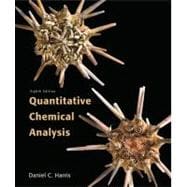The most widely used analytical chemistry textbook in the world, Dan Harris's Quantitative Chemical Analysis provides a sound physical understanding of the principles of analytical chemistry, showing how these principles are applied in chemistry and related disciplines especially in life sciences and environmental science. As always, the new edition incorporates real data, spreadsheets, and a wealth of applications, in a witty, personable presentation that engages students without compromising the depth necessary for a thorough and practical understanding of analytical chemistry.
New to this Edition
-New “Ask Yourself” questions at the end of each worked example, giving students the opportunity to evaluate their understanding of the concepts involved in the problem.
-Additional multi step worked examples to help students develop their skills at solving more complex problems.
-Revised and updated coverage of spectroscopy, expanded coverage of statistics, and updated applications throughout, especially in the areas of nanotechnology and environmental chemistry.
-Updated Excel coverage with spreadsheet instructions, tips, and applications for Excel are now based on the 2007 edition of the program.
-New Lecture PowerPoints available on the Eighth Edition’s Book Companion Site all formatting for optimum projection and easily customizable.
-Superb Media, including a fully interactive eBook and online homework via WebAssign.








